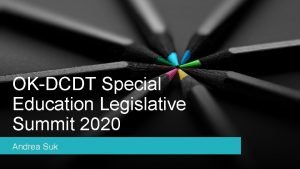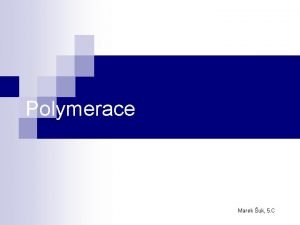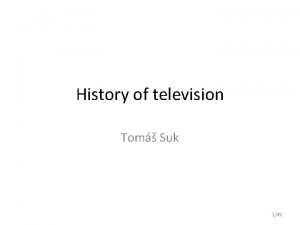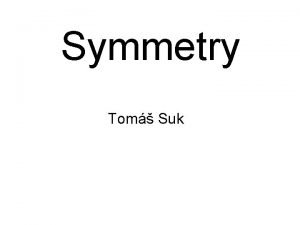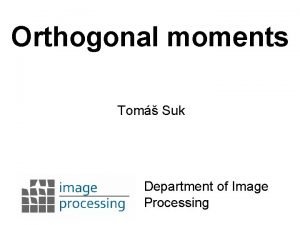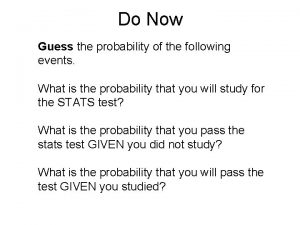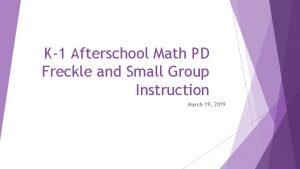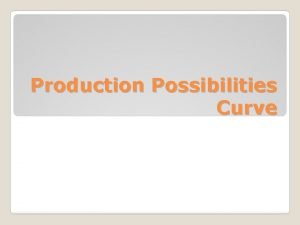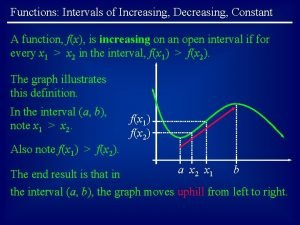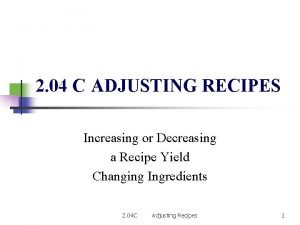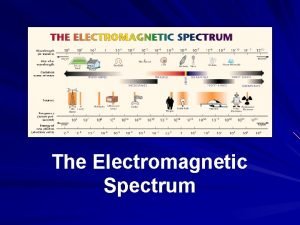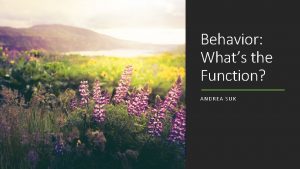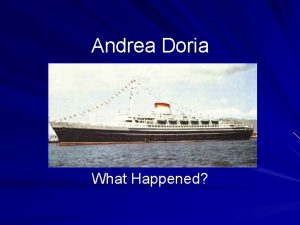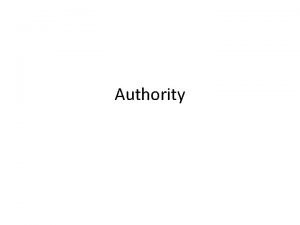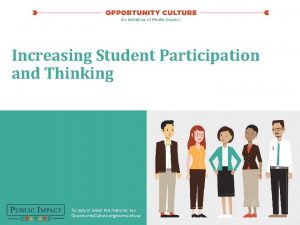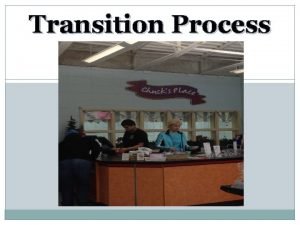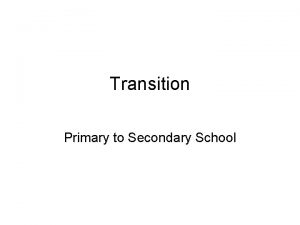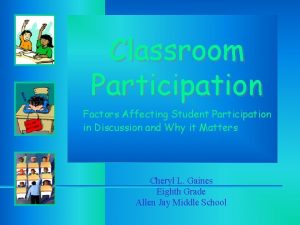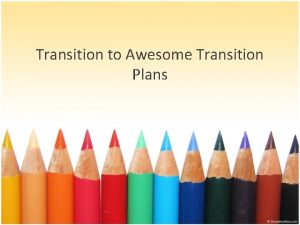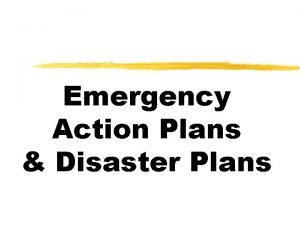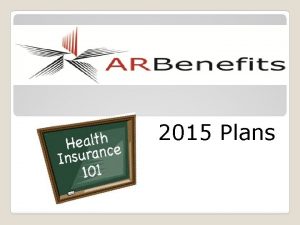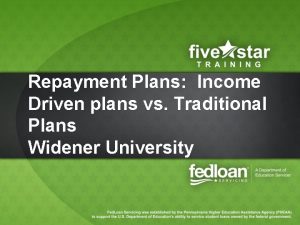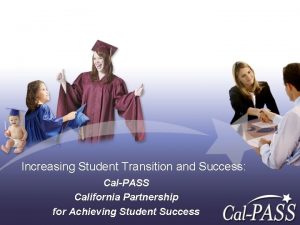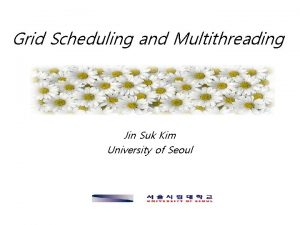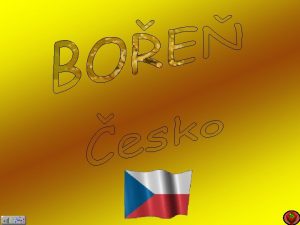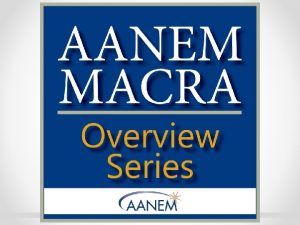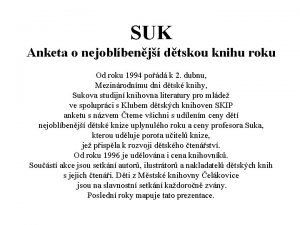Increasing Student Participation in Transition Plans Andrea Suk

























- Slides: 25

Increasing Student Participation in Transition Plans Andrea Suk & Malarie Deardorff

Overview Transition should be a process and preparation that is directed by a student’s future goals, which is supported by family/school personnel/agency staff/community members to have experiences, academics and annual goals that directly link to the post-school desired outcomes.

Topics of Discussion – Current Research – Assessments – Increasing Student Participation – Self-Determination – Self-Directed IEPs – Resources (collaboration) – Example Lesson Plans

Current Research – Current research links student involvement in the transition process and IEP meetings can increase student engagement in transition planning. – When students are engaged in the transition process it can lead to increased number of met transition goals that directly links to post-school outcomes; employment, post-secondary education, and community participation (Martin & Williams-Diehm, 2013). – Individuals from the early transition states were more likely to be employed by the time their cases were closed than their match peers from later transition states (Cimera, Burgess & Bedesem, 2014)

Laws IDEA states transition services are required for students with disabilities at the age of 16 or younger if states determine necessary. Oklahoma requires transition to begin by 16 or ninth grade, which ever comes first.

So, I have this student…. Where do I start? ?

Assessments – Formal vs. informal – Free vs costs money – Long vs short Must include employment and education/training. Might include independent living. Can include selfdetermination!

Assessments Formal - Wide Range Interest and Occupational Test (WRIOT) - $$$$ - Brigance Employability Skills Inventory - $599. 00 - Vineland Adaptive Behavior Scales - $281 - $747+ - Transition Planning Inventory 2 (TPI) - $269. 00 – Pro-Ed but sections are less - Employability and Independent Living Assessment - Free online - TAGG – Transition Assessment and Goal Generator - $3 per student package – Zarrow Center - ARC Self-Determination Scale and AIR Self-Determination Assessment - Free on Zarrow website - Choice. Maker Self-Determination Assessment - Free on Zarrow website

Assessments Informal ENDLESS OPTIONS!!!!! Quick. Book of Transition Assessments Informal Assessments for Transition (book by Pro-Ed) • Postsecondary Education and Training • Employment and Career Planning • Independent Living and Community Participation Free Online – Ocali All 3 for $121. 00 or $47. 00 each

Assessments for Middle/Elementary School – Career View http: //www. vaview. vt. edu/ – PAWS in Jobland http: //paws. bridges. com/cfnc 1. htm – Drive of Your Life https: //www. driveofyourlife. org/main/index. html – PBS Kids Curious George http: //pbskids. org/curiousgeorge/games/on_the_job/

Assessment Information – Turn the data into INFORMATION – What does the student want to do when he/she grows up? – Does the student want to go to college? – Where does the student want to live? – What skills do they have now that support them reaching those goals? ? – What skills do students need to learn to reach those goals? ?

Who is driving? – The STUDENT is their own driving force – Supported by teachers – Supported by family – Supported by agencies – Supported by the community How do we ensure that students are prepared to be a driving force? ? ?

Increase Student Participation – Teach Self-Determination – Teach and follow through on Self-Directed IEPs – Provide meaningful resources and collaboration

Teaching Self-Determination What can you do in your classroom? • Promoting Choice Making • Encourage Exploration of Possibilities • Facilitate Development of Self. Esteem • Develop Goal Setting and Planning • Promote Reasonable Risk Taking • Help Youth Understand Their Disabilities • Encourage Problem Solving • ME! – bell work examples (Zarrow Center website) • Promote Self Advocacy http: //www. ncset. org/publications/viewdesc. asp? id=962 • I am determined www. iamdetermined. org

http: //www. ou. edu/content/dam/Education/zarrow/Choice. Maker%20 materi als/info. Self-Directed%20 IEP-rev. pdf Self-Directed IEP – Self-Directed IEP Curriculum – Students that self-directed their own IEPs – Attended more of their IEP meetings – Had more parents attend IEP meetings – Talked more about their interests – Shared more of their dreams – Talked more about the job they wanted after leaving school – Felt like they were the boss of their IEP meeting – Felt more confident in reaching their IEP goals

Self-Directed IEP – Student created powerpoints, videos, or one-pagers to show their own preferences for accommodations, postsecondary goals, academic goals, strengths and weaknesses – Attending the IEP is not the same as participating – Begin in Elementary – Teaching self-advocacy, self-determination, and social skills – Career Awareness – Transition skills assessments/goals

Meaningful Resources and Collaboration – Department of Rehabilitation Services – In-Home Supports Waivers vs Community-Based Waivers – Developmental Disabilities and Service Division – Waiting lists can be long and the process to get help from the agencies may take a few years. Be sure to include the resources for parents to view in ninth grade or sooner! Start the waiting list process sooner. – As of September 8 th, 2016 – 7, 436 people with disabilities are waiting for services (okwaitinglist. org)

Meaningful Resources and Collaboration – Oklahoma Rehabilitation Council Youth Plan https: //www. ok. gov/orc – Oklahoma Able Tech http: //www. okabletech. okstate. edu – Oklahoma Department of Rehabilitation Services http: //www. okdrs. org – Transition: School-to-Work http: //www. okrehab. org/drupal/students/tran sition – Oklahoma Transition Institute http: //www. okdrs. org/drupal/node/4835 – Aging Out resources specific to Oklahoma. http: //agingoutinstitute. com/select-yourstate/oklahoma/ – Oklahoma Parents Center http: //oklahomaparentscenter. org/youth/tran – Health Care Transition Resources sition-school-to-work/ http: //gottransition. org/resources/index. cfm

Collaboration with General Education – Co-teaching – Use the lessons provided in classes that have both special education and regular education students – Teaching the standards while helping students with disabilities (and others) meet post-secondary goals. – Send out a powerpoint, videos, handouts on transition planning to general educators in your building – Talking to general education teachers!!!

Example Lesson Plans both – Math – CCSS ELA continuum (Mc. Connell, 2016) – ELA – Social Studies Lesson Plan (middle school) – English Lesson Plan (elementary school) – NTACT



Science Lessons incorporating Transition skills – Cooking, measuring, independent living skills combined with Science Skills for High School – http: //extension. uga. edu/k 12/scienc e-behind-our-food/food-science. cfm – http: //www. kids-cookingactivities. com/food-scienceexperiments. html

Transition On the Right Track…. . YES ✔Do students know how to make decisions and live the effects of those decisions? ✔Are students as independent as possible? Are we teaching towards more independence? ✔Do students have enough life experiences to have future goals? ✔Do students have future goals and annual goals that are linked? ✔Are students with peers without disabilities? ✔Are students and families learning how to navigate agencies? ✔Are students receiving the support required, without being “over supported”? ✔Are students on all applicable waiting lists?

References – Zarrow Center - http: //www. ou. edu/education/centers-and-partnerships/zarrow. html – Employability and Life Skills Assessment - https: //www. iidc. indiana. edu/styles/iidc/defiles/INSTRC/Webinars/Employability_skills_checklist. pdf – Quick. Book Transition Assessment - http: //www. ocali. org/up_doc/Quickbook_of_Transition_Assessment. pdf – NTACT Lesson Plans- http: //www. transitionta. org/researchpractices – Martin, J. E. , & Williams-Diehm, K. (2013). Student engagement and leadership of the transition planning process. Career Development and Transition for Exceptional Individuals, 2165143413476545. – Cimera, R. E. , Brugess, S. , & Bedesem, P. L. (2014). Does providing transition services by age 14 produce better outcomes for students with intellectual disabilities? Research and Practice for Persons with Severe Disabilities, 39 (1), 47 -54.
 Andrea suk
Andrea suk Contoh total participation
Contoh total participation Iontová polymerace
Iontová polymerace Tom suk
Tom suk Hwang woo-suk
Hwang woo-suk 2 fold symmetry
2 fold symmetry česky
česky Tom suk
Tom suk Andrea is a very good student. the probability
Andrea is a very good student. the probability Teacher good morning everyone
Teacher good morning everyone Freckle.student.login
Freckle.student.login National student clearinghouse student tracker
National student clearinghouse student tracker Sls singapore student learning space
Sls singapore student learning space Class maths student student1 class student string name
Class maths student student1 class student string name Your last weekend
Your last weekend National student clearinghouse student tracker
National student clearinghouse student tracker We ...... a big piece of wood last saturday. (see)
We ...... a big piece of wood last saturday. (see) Law of increasing opportunity cost
Law of increasing opportunity cost Law of increasing opportunity cost
Law of increasing opportunity cost Bulk gaining product example
Bulk gaining product example Increasing decreasing constant
Increasing decreasing constant Increasing quantities
Increasing quantities Atomic size
Atomic size Increasing and decreasing recipes
Increasing and decreasing recipes Electromagenetic spectrum
Electromagenetic spectrum Compared to a gear tooth on the rear sprocket
Compared to a gear tooth on the rear sprocket
